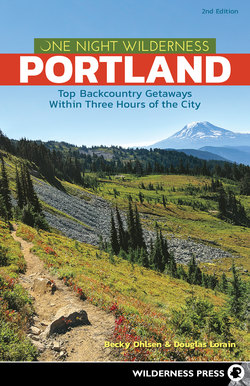Читать книгу One Night Wilderness: Portland - Becky Ohlsen - Страница 20
На сайте Литреса книга снята с продажи.
Оглавление| 8 | Cispus Point |
| RATINGS | Scenery 7 Difficulty 4 Solitude 9 | |
| ROUND-TRIP DISTANCE | 5.6 miles (including side trip) | |
| ELEVATION GAIN | 1,400' | |
| OPTIONAL MAP | Green Trails Blue Lake (No. 334) | |
| USUALLY OPEN | July–October | |
| BEST TIME | July | |
| AGENCY | Cowlitz Valley Ranger District (Gifford Pinchot National Forest), fs.usda.gov/ recarea/giffordpinchot /recarea/?recid=31180 | |
| PERMIT | None |
Highlights
This short but exciting hike takes you into a small but very attractive parcel of roadless terrain not far from Packwood, Washington. Because most hikers prefer the more famous trails around the scenic wonders of nearby Mount Rainier and the Goat Rocks, it’s not surprising that few people visit Cispus Point. (On an early September weekend, there was not another car anywhere near the trailhead.) Those who do visit are rewarded not only with solitude but also with exceptional scenery, including spectacular 360-degree views that take in all of those much more crowded attractions.
Getting There
From I-5, 67 miles north of Vancouver, Washington, take Exit 68 and travel 61 miles east on US 12 to an unsigned junction with Forest Service Road 20 near milepost 127.6. Turn right (south) on this narrow and sometimes rough gravel road. Continue on the main route 12.2 miles through several minor intersections. Park at a pullout on the left, about 0.5 mile past the (possibly unsigned, and certainly easy to miss) trailhead for Jackpot Lake (Klickitat Trail) and just before the road takes a sharp right.
GPS COORDINATES N46° 28.116' W121° 42.278'
Hiking It
The unsigned but obvious trail goes southwest along the edge of an old, now enthusiastically regrowing clear-cut for 0.2 mile to a junction with the Klickitat Trail. Turn right and wander through a forest of mountain hemlocks and Alaska yellow cedars, which provide lots of welcome shade but block most of the views. In July, wildflowers such as valerian, avalanche lily, columbine, wallflower, pink heather, bluebell, and lupine provide plenty of color, especially in places that get a bit more sun. Those breaks in the forest cover also provide views of bulky, snow-covered Mount Adams to the south.
